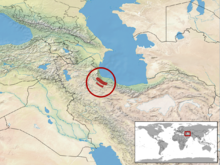Montivipera raddei albicornuta is a venomous viper subspecies endemic to Iran.[1][3] It is a subspecies of Montivipera raddei.
| Montivipera raddei albicornuta | |
|---|---|
| Scientific classification | |
| Domain: | Eukaryota |
| Kingdom: | Animalia |
| Phylum: | Chordata |
| Class: | Reptilia |
| Order: | Squamata |
| Suborder: | Serpentes |
| Family: | Viperidae |
| Genus: | Montivipera |
| Species: | |
| Subspecies: | M. r. albicornuta
|
| Trinomial name | |
| Montivipera raddei albicornuta Nilson & Andrén, 1985
| |

| |
| Synonyms[1] | |
| |
- Common names: Iranian mountain viper, zigzag mountain viper.[2]
Description edit
Grows to a maximum total length of 66 cm (26 in).[2]
The head is relatively small and elongated, although fairly distinct from the neck. The supraoculars are raised and separated from the eyes by a row of small scales. The nostril is centered in a large nasal scale that is partially fused with the prenasals. A loreal scale is present between the upper preocular and nasal. The supraoculars are separated by at least 7 scales, and by a total of 24-28 scales. The supraocular are separated from the supranasals by 2 canthal scales. 2 apical scales border the rostral. The rostral is wider than it is high. There are 12-16 intercanthals. The total number of scales on the top of the head is 39-40. There are 13-15 circumorbital scales with an incomplete outer ring of 13-17 scales. There are supralabials 9, separated from the eye by 1-2 scale rows. There are 11-12 sublabials, 2 large anterior chin shields, 4 posterior chin shields and 2-3 preventrals.[2]
Midbody there are 23 dorsal scale rows. The ventrals number 165-171. There are 35-38 subcaudals (in males). The anal scale is single.[2]
The color pattern consists of a grayish brown ground color with a darker brown zigzig pattern, made up of about 44-52 windings and edged with black. The belly is dark and mottled with a lighter shade. On the head, deep black bands run from the back of the eye to the angle of the mouth. Supraoculars noticeably pale. There is a row of dark blotches along each side of the dorsum. The back of the head has distinct, teardrop-shaped deep black spots. The throat is whitish with dark mottling.[2]
Geographic range edit
It is found in the Zanjan Valley and surrounding mountains in northwestern Iran. The type locality given is "Abhar in the Zanjan valley, between Tabriz and Teheran".[1] Mallow et al. (1993) describe the range as "parts of the Elburz, Talysh and Zanjan mountains".[2]
References edit
- ^ a b c McDiarmid RW, Campbell JA, Touré T. 1999. Snake Species of the World: A Taxonomic and Geographic Reference, Volume 1. Herpetologists' League. 511 pp. ISBN 1-893777-00-6 (series). ISBN 1-893777-01-4 (volume).
- ^ a b c d e f Mallow D, Ludwig D, Nilson G. 2003. True Vipers: Natural History and Toxinology of Old World Vipers. Krieger Publishing Company, Malabar, Florida. 359 pp. ISBN 0-89464-877-2.
- ^ "Vipera albicornuta". Integrated Taxonomic Information System. Retrieved 6 August 2006.
Further reading edit
- Golay P, Smith HM, Broadley DG, Dixon JR, McCarthy CJ, Golray P, Schatti J-C, Toriba M. 1993. Endoglyphs and Other Major Venomous Snakes of the World: A Checklist. New York: Springer-Verlag. 393 pp.
- Nilson G, Andrén C. 1986. The mountain vipers of the Middle East – the Vipera xanthina complex (Reptilia: Viperidae). Bonner Zoologische Beiträge 20: 1-90.